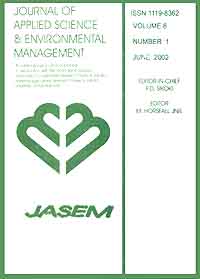
|
Journal of Applied Sciences and Environmental Management
World Bank assisted National Agricultural Research Project (NARP) - University of Port Harcourt
ISSN: 1119-8362
Vol. 18, No. 2, 2014, pp. 309-316
|
 Bioline Code: ja14043
Bioline Code: ja14043
Full paper language: English
Document type: Research Article
Document available free of charge
|
|
|
Journal of Applied Sciences and Environmental Management, Vol. 18, No. 2, 2014, pp. 309-316
| en |
Fate, Distribution and Sources of Polycyclic Aromatic Hydrocarbons (PAHs) in Contaminated Soils in Parts of Calabar Metropolis, South Eastern Nigeria
NGANJE, T.N.; NEJI, P.A.; IBE, K.A.; ADAMU, C.I. & EDET, A.
Abstract
The paper is aimed at the investigation of polycyclic aromatic hydrocarbons (PAHs) in contaminated soils collected at depths of 15 to 100cm from two spilled sites in the vicinity of a leaking pipeline (Calabar, Nigeria). The soils were prepared in the laboratory using standard procedure and were analyzed for sixteen priority PAHs using Gas Chromatography – Mass Spectrophotometer (GC - MS).The concentration of total PAHs (TPAHs) in the contaminated soils ranged from 4.28 to 29.77mg/Kg and decreased with depth. These levels are higher than values obtained from rural and semi urban soils but lower than values obtained from soils in the vicinity of some petroleum handling facilities in part of the study area. Generally the soils were relatively enriched with medium- and lower-molecular-weight PAHs. Phenanthrene/Anthracene, Fluoranthene/Pyrene, Fluorantine/Fluorantine+Pyrene and Benzo(A)Anthracene/Chrysene ratios and the relative abundance of PAHs according to the number of rings were used to access the sources of PAHs. In addition, the main mechanism of PAHs transport in the study area was proposed.
Keywords
Fate; Distribution; Sources; PAHs; Soils; contaminated soils; Calabar
|
| |
© Copyright 2014 - Journal of Applied Sciences and Environmental Management
|
|
